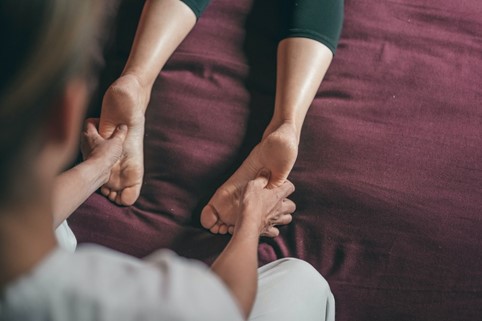Foot pain: common causes and remedies

The feet bear the weight of the body when we are standing and help us to get wherever we want to go. This is why foot pain is a very common condition that may be caused by incorrect posture, minor traumas or a pathological condition. When we talk of generic “foot pain”, it is worth trying to identify the precise area where we feel the pain, which may be the heel or the sole of the foot, remembering that we may feel pain in several areas at the same time.
Sometimes the pain goes away during the day with appropriate rest, but in some cases, it may continue for many days. So, what can we do? Let’s find out in this article.
Table of contents:
- The foot: anatomical and bio-mechanical insights
- The 11 most common causes of foot pain
- Different types of foot pain
- Sole and heel pain: causes and remedies
- Pain on the outer foot and ankle
- Big toe pain
- Pain in the metatarsal area
- What to do in the case of foot pain
The foot: anatomical and bio-mechanical insights
The foot is the last segment of the lower limb and represents the point fixed to the ground on which the whole weight of the body is placed. In fact, it lies at the base of the anti-gravity control system (governing posture and balance) which allows humans to stand upright and move around.
It is both effector and receptor, meaning that it both receives and carries out the commands through the muscles and, at the same time, interacts with the rest of the body, constantly providing information from the exteroceptors in the skin, found in the sole, and the proprioceptors in the muscles, tendons and joints.
In anatomical terms, the foot is a complex structure, consisting of 26 bones (phalanges, metatarsals and the 7 tarsal bones: talus, calcaneus, navicular, cuboid and the 3 cuneiforms), 33 joints and over one hundred muscles, tendons and ligaments. The most important ligaments are the anterior Talo-fibular, the posterior Talo-fibular and the Deltoid Ligament (often involved in ankle sprains). Another important element is the plantar fascia, underneath the foot.
The 11 most common causes of foot pain
There are numerous causes of foot pain. Here are the 11 most common ones:
- Plantar Fasciitis
- Morton’s Neuroma
- Arthrosis
- Stress fractures and micro-fractures
- Sprains
- Dislocations
- Ligament tears
- Nerve compression syndrome (tarsal tunnel syndrome or tibial nerve syndrome)
- Inflammatory tendon disorders and tendinopathy
- Bunions
- Flat feet or high arch
Different types of foot pain
There are different types of foot pain, which may concentrate in different parts of the foot. Let’s see what they are, and what treatments can be used for them.
Sole and heel pain: causes and remedies
One of the main causes of pain in the sole of the foot is Plantar Fasciitis. This is an inflammation of the fascia covering the muscles on the sole of the foot. It causes pain around the insertion area on the calcaneus (heel) and in the middle of the sole, causing functional weakness in the foot.
The causes may be related to alterations in the foot position, inappropriate footwear, overload, excessive retraction of the rear muscle chain or other problems.
Treatment includes rest, physiotherapy (ESWT, TECAR, LASER), specific exercises to improve flexibility in the calf and foot arch, as well as manual therapy techniques. In some cases, orthotic insoles made by a podiatrist may be needed, or infiltrations performed by a doctor.
Pain on the outer foot and ankle
Pain on the outer foot is often cause by trauma, i.e. a sprain. A sprain is caused by an incorrect and exaggerated reverse movement of the ankle joint. In these cases, the ankle ligaments are subjected to excessive stress, which can cause a strain or even lead to a breakage.
Another possible cause of pain in the outer area of the foot/ankle is tendon inflammation, particularly of the insertional tendons in the peroneus muscles.
In both cases, physiotherapy is the most recommended treatment.
Big toe pain
There are many causes of pain in the big toe, from systemic illnesses such as Gout, Arthrosis and rheumatoid illness such as Rheumatoid Arthritis. However, if the pain is accompanied by a deformation of the metatarsophalangeal joint or the toe points inwards towards the other toes, it is very probably a Bunion. In this case, the first thing to do is consult an Orthopaedic foot specialist, who will decide whether surgery is necessary or if the patient should undergo conservative therapy with drugs, physiotherapy and podiatric and postural treatments.
Pain in the metatarsal area
If the pain is caused during the push phase of walking, in the metatarsal head area, often this is a disease called Morton’s Disease (or Morton’s Neuroma). This is a compression metatarsalgia, affecting the digital plantar nerves. One of the signs of this condition is the flattening of the plantar arch, which also makes it easier to occur. As explained, the symptoms appear when walking, due to the compression of the digital plantar nerves between the plantar aponeurosis and the deep plantar fascia. The Orthopaedic foot specialist will prescribe the best treatment, which may also include the use of metatarsal insoles.
What to do in the case of foot pain
First of all, given the variety of illnesses in this segment, whether the pain occurs following trauma or spontaneously, it is worth consulting a doctor, who may prescribe diagnostic tests, including an x-ray, ultrasound scan or MRI.
Depending on the following diagnosis, the prescribed treatment may be conservative, with a physiotherapist and/or podiatrist, or a consult with an Orthopaedic foot specialist to assess the need for surgery.
Sources:
“Nuovo trattato di medicina fisica e riabilitazione”, a cura di Valobra, Gatto e Monticone.



